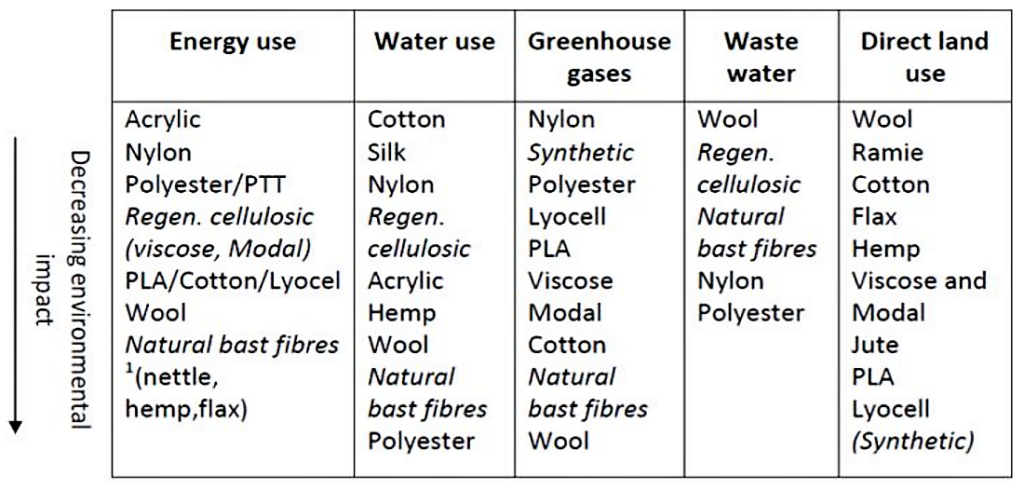The fashion industry is responsible for 10% of annual global carbon emissions. That means it is a productive target for personal changes that can make a significant contribution to lowering overall human carbon emissions.
You can use thredUP’s fashion footprint calculator to estimate your personal fashion footprint. When you must buy new clothes, you can look for sustainable clothing brands. But these can be expensive and tend to have limited options. Since fabric production accounts for roughly 59% of a garment’s climate impact, paying attention to which fabrics you buy could help you minimize the impact of your wardrobe refresh.
In general, natural fibers tend to use less energy than synthetics, which indicates a lower climate impact. But natural fibers are often more damaging in terms of immediate environmental impacts such as land use, water consumption, and ecotoxicity from chemical fertilizers, pesticides, and dyes.

Good
Cotton
Cotton is the largest non-food crop in the world, and unfortunately, it’s immediate environmental impacts are severe. Growing cotton consumes and pollutes vast quantities of water, degrades soil, and generates chemical pollution that harms workers and habitats. But these impacts and greenhouse gas emissions can vary widely depending on where and how the plant was grown.
| Cotton Type | Kg of CO2 emissions per ton of spun fiber |
| Conventional cotton (USA) | 5.9 |
| Organic cotton (USA) | 2.35 |
| Organic cotton (India) | 3.8 |
| DATA SOURCE | |
But cutting cotton from one’s closet would be a challenge. To do some good, pay the cost premium for domestically produced organic cotton.
Silk
Silk is a protein-based fabric, made from the cocoons of Bombyx mori, which is killed in the process of extracting the filament. Sericulture (silk farming) usually occurs in countries where obtaining reliable data is challenging and worker conditions are uncertain. Invasive in America, the mulberry tree is a low-impact crop in Asia that requires few chemical inputs.
The Higg Materials Sustainability Index ranks silk’s impacts higher than most fibers due to fossil fuel use during processing. However, at least one study indicates that carbon sequestration on mulberry plantations may make silk production carbon positive.
If you’re going to spend the money on silk, it’s good to look for the Global Organic Textile Standard (GOTS) label. Wild silk (aka Peace or Ahimsa silk) is lower quality and can be hard to find but does not require boiling the larvae.
Wool
Wool is a protein-based fiber, usually sourced from sheep, but sometimes from goats, alpacas, camels, and even rabbits. Although wool fibers can be collected without killing the animal, there are still animal welfare considerations – these are particularly well-documented for mohair goats.
One study estimated that a kilogram of fine-grade wool generates from 7.83 to 18.70 kilograms of CO2 equivalent. That’s a much higher climate impact than cotton. But the production of wool garments does not require large amounts of chemicals or dyes, and the resulting yarn is easily recycled and biodegradable.
Especially if you’re avoiding synthetic fabrics, you may find some wool clothing necessary. In that case, it’s good to look for certified wool. The Responsible Wool Standard (RWS) is one prominent wool certification group; Woolmark and the International Wool Textile Organization (IWTO) are two others.
Better
Cellulosic Fibers
Rayon (aka viscose) is made by extracting cellulose from wood using solvents. The primary solvent, carbon disulfide, is highly toxic. Manufacturers rarely recycle it and often release it into the environment, although better production methods are catching on. Some rayon might be made from illegally logged wood. Due to its complex manufacturing practice, in the sole qualitative comparison between common textiles, rayon ranked the highest greenhouse gas emissions of any natural fiber.

Image source
Despite potentially higher carbon emissions, rayon has lower impacts from land use, dyeing, and finishing processes than cotton. Particularly Tencel rayon, made from certified wood with recycled solvent, can be a better choice than cotton or protein-based fabrics.
Bast Fibers (Hemp, Linen, Jute)
Bast fibers are made from the stems of plants like hemp, jute, or flax (which makes linen). In general, these plants require little water and fertilizer to grow. No part of the hemp plant is wasted, and hemp fibers have even been shown to have antibacterial properties. Although bast fibers are not without environmental impacts – especially in the chemicals used for processing, organic hemp and organic flax are among the most sustainable fibers according to the Made-By Environmental Benchmark for Fibers. Even when they’re not organic, bast fibers are a better textile choice.
Best
What is the best natural fiber for the environment? Unfortunately, it’s impossible to say.
The fashion industry involves convoluted supply chains and opaque industrial practices. As a result, the life cycle analysis of various textiles is incomplete and inconsistent. Emerging textiles like bamboo might be more sustainable, but there simply isn’t enough data to know yet.
In the absence of truly sustainable options, buy the clothes that work best for you and wear them out. When shopping for natural fibers, look for organic and untreated options. Before you shop, apply strategies for reducing your consumer carbon footprint to your closet. Because regardless of your fabric choice, buying less is the best choice.
The post Good, Better, Best: Shopping for Natural Fibers appeared first on Earth 911.







